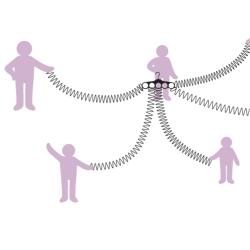Source Institutions
Source Institutions
Add to list Go to activity
Activity link broken? See if it's at the internet archive

In this activity, learners sort different natural phenomena into categories (they occur on Earth, on the Moon, or on both), and then model how energy moves during a quake using spring toys. Additionally, learners can explore where the Apollo missions landed on the Moon and discuss how NASA scientists use special tools to measure quakes on the Moon. Activity includes a facilitation guide with potential misconceptions, Earth & space science infosheets with NASA connections, table sign, and activity training video. All public-facing materials also available in Spanish.
- 5 to 10 minutes
- 5 to 10 minutes
- $10 - $20 per group of students
- Ages 6 - 18
- Activity, Model
- English, Spanish
Quick Guide
Materials List (per group of students)
- Earth and Moon Venn diagram (sorting mat)
- Sorting cards
- Scarf hanger
- 3–5 spring toys
- 3–5 small carabiners
- Moon (& optional Earth) ball
- Apollo Landing Sites map
Subjects
-
Earth and Space Science
-
Solar System
- The Moon
-
Solar System
Informal Categories
- Nature and Environment
- Toys
Other
Foreign language versions of this resource:
- Spanish: Activity Guide (Spanish)
- Spanish: Instructions (Spanish)
- Spanish: Activity Sign (Spanish)
- Spanish: Apollo Landing Sight Graphic (Spanish)
- Spanish: Info Sheet 2
- Spanish: Info Sheet 3 (Spanish)
Components that are part of this resource:
- Activity Facilitation Training Video
- Activity Content Training Video
- Facilitator Guide
- Activity Guide
- Instructions
- Activity Sign
- Apollo Landing Sight Graphic
- Info Sheet 1
- Info Sheet 2
- Info Sheet 3
- Sorting Cards
- Sorting Mat
Access Rights:
- Free access
By:
Rights:
- Creative Commons: Non-commercial Share Alike (by-nc-sa), Sciencenter, 2020
Funding Sources:
- NASA, NNX16AC67A
- NASA, 80NSSC18M0061
